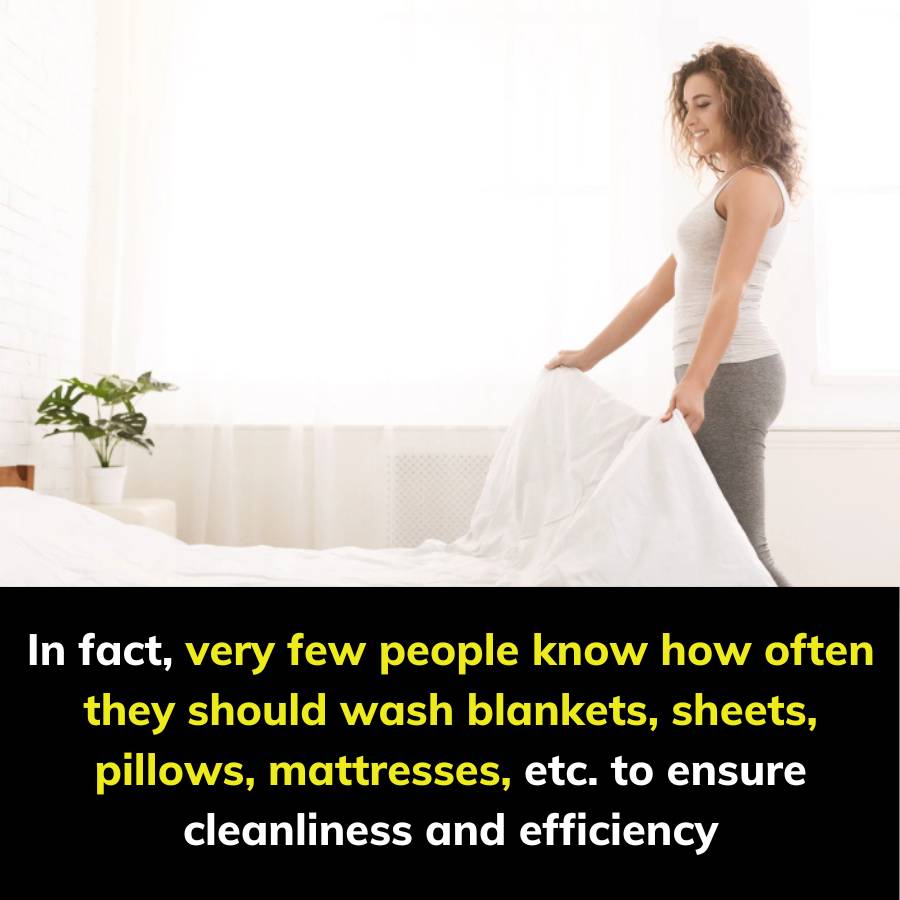
To have a good, comfortable sleep and ensure the health of the whole family, you should pay attention to periodically cleaning the bedding, mattress, and sleeping mat. This will avoid pathogens and eliminate mold bacteria.However, in reality, very few people know how often to wash blankets, sheets, pillows, mattresses, etc. to ensure cleanliness and effectiveness.
If you only clean blankets, sheets, pillows, etc. by vacuuming or shaking off dirt, it is not enough because there are still bacteria that affect human health. Therefore, you should wash each type according to the frequency below and pay attention to drying clothes on sunny days, avoiding rainy and windy days that cause mold on blankets, sheets, and pillows.
1. Blanket cover
You need to know the frequency of using the blanket to choose a reasonable washing frequency.
If you use the blanket every day, you need to wash it regularly after one or two weeks. But if you rarely use the blanket, you only need to wash it once every few months.
If the blanket is not used often, be careful when washing to avoid fading the blanket onto your clothes. It is best to wash the blanket separately so you don’t have to worry about this situation.
On the other hand, you should also regularly dry the blanket and pillowcase in the sun to kill a series of bacteria and pathogens. And remember to replace the blanket after 5 years of use.2. Blanket lining
Over time, the blanket lining will also become covered with dirt and sweat. Therefore, you need to wash the blanket at least once a year.
However, you should only dry clean it, not wash it by machine, especially feather blankets. If the blanket is not stained, just drying it in the sun is enough to kill bacteria and harmful pathogens.
3. Bed sheets and pillowcases
Experts recommend washing bed sheets and pillowcases at least once a week. Bed sheets easily absorb oil and dirt from the human body, which will become stubborn stains if left for a long time. Not to mention, bed sheets are also a place where dead skin, bacteria and pathogens from the human body accumulate. Dust mites cling to dead skin and the molecules of these microscopic insects can make the health of people with allergies worse.
Take advantage of drying clothes on sunny days, avoid rainy and windy days that cause mold on bedding.
Even if you wash regularly, you should check and treat stains as soon as possible. You should wash sheets with warm water at about 50-60 degrees Celsius and dry them in sunlight to kill all fungi, mold and pathogens on sheets and pillows. In addition, open the windows every morning to release moisture and remove bacteria on bed sheets.
4. Pillow stuffing
If you use pillowcases, you only need to wash the pillow stuffing about three times a year.
If you do not use pillowcases, you need to wash the pillow stuffing monthly or at least once every two months. Most washing machines can wash a pair of pillow stuffing at the same time. And you should not wash each pillow separately because it will cause the washing machine to lose balance.
5. Mattress
Daily mattresses should be cleaned after about three months, but if the mattress is dirty or has liquid spilled on it, it needs to be cleaned immediately. You can use a vacuum cleaner to remove dirt on the mattress surface and put the mattress out in the sun to dry the mattress, while limiting the growth of bacteria.
6. Sleeping mat
For sleeping mats that are lighter and thinner, you should clean them with clean water or wash them directly, but do not rub too hard to avoid damaging the mat. Then dry them for about 8-12 hours depending on the weather and sunlight. Absolutely do not lie on a damp mat because it is easy to cause disease-causing bacteria.

